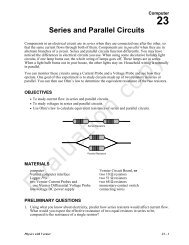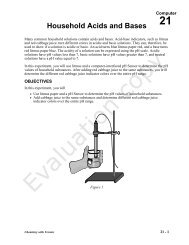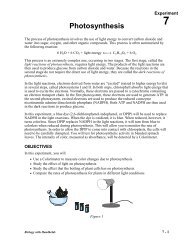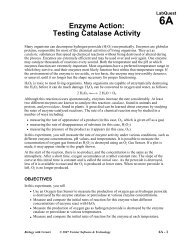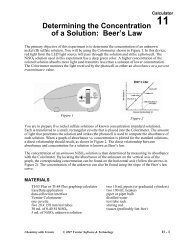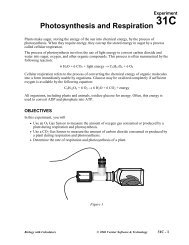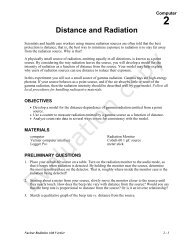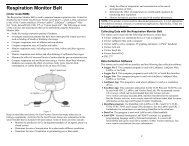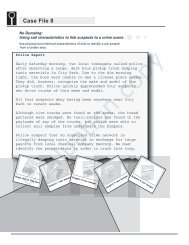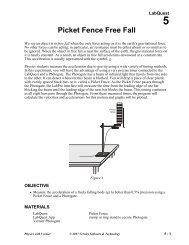Activities for the Wireless Dynamics Sensor System - Vernier ...
Activities for the Wireless Dynamics Sensor System - Vernier ...
Activities for the Wireless Dynamics Sensor System - Vernier ...
Create successful ePaper yourself
Turn your PDF publications into a flip-book with our unique Google optimized e-Paper software.
<strong>Activities</strong> <strong>for</strong> <strong>the</strong> <strong>Wireless</strong> <strong>Dynamics</strong> <strong>Sensor</strong> <strong>System</strong>Also, uncheck <strong>the</strong> Sample at Time Zero box if it is selected.8. Click on <strong>the</strong> Triggering tab and set up <strong>the</strong> WDSS to triggerand begin recording data when <strong>the</strong> <strong>for</strong>ce increases above0.1 N as indicated in Figure 4.The Simulated Landings9. Attach <strong>the</strong> PVC tubing to <strong>the</strong> ring stand using <strong>the</strong> buretteclamp. Be sure <strong>the</strong> tubing is directly above <strong>the</strong> base of <strong>the</strong>stand. Insert <strong>the</strong> wooden dowel into <strong>the</strong> PVC tubing with<strong>the</strong> threaded end pointing down towards <strong>the</strong> ring standbase.10. Screw <strong>the</strong> bumper into <strong>the</strong> <strong>for</strong>ce sensor end of <strong>the</strong> WDSS.Thread <strong>the</strong> WDSS onto <strong>the</strong> wooden dowel using <strong>the</strong>mounting hole at <strong>the</strong> end opposite <strong>the</strong> bumper. Align <strong>the</strong>bumper so it is centered above <strong>the</strong> base of <strong>the</strong> ring stand.Raise <strong>the</strong> WDSS as high as it can go and hold it in placewith <strong>the</strong> clo<strong>the</strong>s pin.Figure 411. Fill <strong>the</strong> soil container 10 cm deep with <strong>the</strong> first test soil. (Since you will be testing allfour types of soil, it does not matter which is done first.) Place <strong>the</strong> soil container on<strong>the</strong> base of <strong>the</strong> ring stand so <strong>the</strong> container is centered directly below <strong>the</strong> WDSS.12. Clickto zero <strong>the</strong> <strong>for</strong>ce sensor.13. Hold <strong>the</strong> wooden dowel and remove <strong>the</strong> clo<strong>the</strong>s pin. Click to prepare <strong>the</strong>WDSS <strong>for</strong> data collection. (The graph will display <strong>the</strong> message “Waiting <strong>for</strong> Trig geror Data…”) Release <strong>the</strong> dowel and allow <strong>the</strong> WDSS to impact <strong>the</strong> soil sample. Whendata collection is complete, raise and secure <strong>the</strong> WDSS to its highest position with <strong>the</strong>clo<strong>the</strong>s pin.14. Study <strong>the</strong> <strong>for</strong>ce-time graph (impact signature) carefully. Pay close attention to how<strong>the</strong> impact <strong>for</strong>ce changes with time and how fast <strong>the</strong> changes take place. You maywant to repeat Step 12 – 13 several times to be sure you understand <strong>the</strong> characteristicsof <strong>the</strong> impact signature <strong>for</strong> this type of soil. Save at least one of your <strong>for</strong>ce-timegraphs by choosing Store Latest Run from <strong>the</strong> Experiments Menu.15. Repeat Steps 11 – 14 using <strong>the</strong> o<strong>the</strong>r three soil samples.QUESTIONS1. Sketch a typical impact signature <strong>for</strong> each of <strong>the</strong> soils you tested. Label <strong>the</strong> keyfeatures of <strong>the</strong> graphs.2. Review <strong>the</strong> Huygens’ probe data. Based on <strong>the</strong> results of your tests, hypo<strong>the</strong>size as to<strong>the</strong> composition of <strong>the</strong> soil on Titan. Defend your hypo<strong>the</strong>sis.3. Describe <strong>the</strong> limitations of this procedure <strong>for</strong> determining <strong>the</strong> composition of Titan’ssoil at <strong>the</strong> location of impact.4. Describe changes to this experiment and additional tests you would recommend totest your hypo<strong>the</strong>sis.© 2007 - <strong>Vernier</strong> Software & Technology 17




